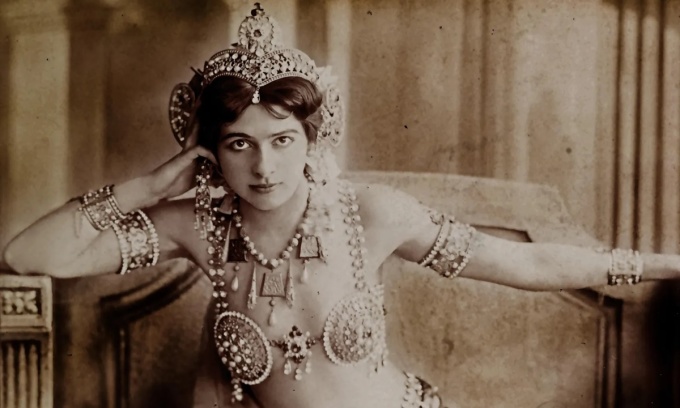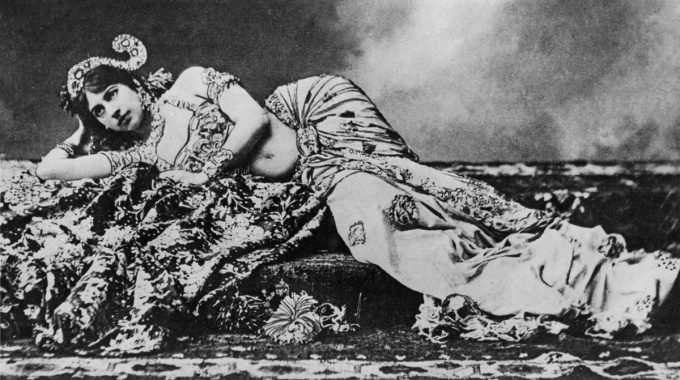Mata Hari was once famous throughout Europe for her beauty and hot dancing but eventually lost her life because of accusations of being a double agent during World War I.
Mata Hari's birth name was Margaretha Geertruida Zelle. Born on August 7, 1876 in Leeuwarden, the Netherlands, Zelle stood out with her dark hair and eyes, different from her friends. Zelle's father was a hat shop owner, quite wealthy and loved his daughter very much.
Zelle's life was difficult early on. Her father went bankrupt in 1889, her parents divorced, and her mother died in 1891. Her father remarried in 1893 and sent Zelle and her siblings to live with their godfather Visser.
She allegedly had an affair with the headmaster of the school in Leiden where she was studying to become a kindergarten teacher. Visser withdrew Zelle from school and she ran away to live with her uncle in The Hague. Zelle was 16 at the time, so historians believe she may have been sexually abused.
At age 18, she fell in love with 39-year-old Dutch soldier Rudolf MacLeod. They married in 1895 and moved to Java, Indonesia, then a colony called the Dutch East Indies. She studied Indonesian culture for months and joined a local dance troupe.

Mata Hari in dancer's costume. Photo: National Library of France
But fate continued to test her. MacLeod drank heavily and had mistresses, which caused her great sadness. The couple had two children, both of whom became seriously ill in 1899. Their son died at the age of two, while only their daughter survived.
After the death of her son, MacLeod left the army, the couple returned to the Netherlands and divorced in 1902. Initially, her daughter lived mostly with her mother, but Zelle had difficulty finding work because there were few jobs for women. With no money to support her child, Zelle had to make a difficult decision. She left her daughter with her ex-husband and moved to Paris, France in 1903.
Zelle struggled to make ends meet in France. From teaching piano to German, she tried to make money any way she could. In 1904, Zelle confessed in a letter that she had turned to prostitution to make ends meet. She also worked as a model for artists.
A friend suggested Zelle take a job as a dancer, which changed her life. By 1905, she had not only achieved success in her new career but also established a new identity.
Identifying herself as a Hindu artist, the daughter of an Indian temple dancer, or a European born on the island of Java, she took the stage name "Mata Hari", which means "eye of the day" in Malay.
She attracted crowds of admirers for her provocative dances, which she labeled "sacred dances." The most famous part of her performance involved her gradually stripping down to her jeweled corset and some ornaments on her arms and head, even exposing her private parts. After her debut in Paris, Mata Hari became known throughout Europe.
Most Europeans at the time knew little about the Dutch East Indies, so Mata Hari's claims of origin were taken at face value. Her performance was successful because it elevated striptease to a higher status,educating audiences about another culture and way of life. She posed for sexy photos and mingled with the wealthy.
By 1910, other dancers began to imitate her. Mata Hari was initially considered a free-spirited artist, but critics later accused her of cheap exhibitionism and lack of artistic value. Mata Hari's career declined after 1912. On March 13, 1915, she gave her final performance.
She had affairs with many high-ranking military officers, politicians and influential people in many countries. That led to tragedy for Mata Hari when World War I broke out.
World War I began from July 1914 to November 1918, between the Triple Entente of France, Britain, Russia and other countries and the Central Powers of Germany, Austria-Hungary, the Ottoman Empire and other countries.
Because the Netherlands was neutral, Hari had no difficulty traveling between countries. Mata Hari had a passionate affair with Captain Vadim Maslov, a 23-year-old Russian pilot serving with the French. Maslov was part of the 50,000-man Russian Expeditionary Force sent to the Western Front in the spring of 1916.
In the summer of 1916, Maslov was wounded in an air battle with the Germans, forcing Mata Hari to ask permission to visit her lover in a hospital near the front. Agents of the Deuxième Bureau, the French military intelligence agency, made it a condition that she would be allowed to see Maslov if she agreed to spy for France.
Before the war, Mata Hari performed several times for the German Crown Prince Wilhelm, a general on the Western Front. The Deuxième Bureau believed that she could seduce the Crown Prince to obtain military secrets and offered her a million francs reward for valuable information. However, the Crown Prince played little role on the battlefield, his image being painted by the German government to cover up bad news.
In late 1916, Mata Hari traveled to Madrid, met with German military attaché Arnold Kalle, and asked him to arrange a meeting with the Crown Prince. During this time, Mata Hari offered to share French secrets with Germany in exchange for money, although it is unclear whether she did so out of greed or in an attempt to arrange a meeting with Crown Prince Wilhelm.
In January 1917, Kalle transmitted radio messages to Berlin, describing a spy codenamed H-21 working for Germany whose description matched Mata Hari. The Deuxième Bureau intercepted the messages and identified H-21 as Mata Hari.
In fact, these messages were sent in a code that German intelligence knew the French had cracked. German intelligence was frustrated that Mata Hari did not provide any valuable information and only told stories about the sex lives of French politicians and generals. So the Germans decided to eliminate Mata Hari by deliberately creating the above messages to get the dancer arrested by the French.
In February 1917, Mata Hari was arrested at her hotel in Paris. She was tried by a military court on July 24, 1917, on charges of spying for Germany and causing the deaths of at least 50,000 soldiers, although they were unable to produce concrete evidence.
Pierre Bouchardon, the Deuxième Bureau official who was in charge of liaising with Mata Hari, argued that the false identity she had created proved that the dancer was a liar and a fraud. Mata Hari admitted that she had received 20,000 francs from a former German diplomat lover to replace assets confiscated by the German government. However, Bouchardon insisted that this was a payment from the Germans for her espionage.
Mata Hari denied this, insisting she had not provided Germany with any valuable information. "I was a slut? Yes. But I was never a traitor."
"I have international connections through my work as a dancer, nothing more. I am not really a spy, it is too bad that I cannot protect myself," Mata Hari wrote in a distress call to the Dutch embassy in Paris.
Regardless of whether Mata Hari was guilty or not, her fate was sealed. She was executed on October 15, 1917. Some witnesses said she blew a kiss to the firing squad before they opened fire.

Mata Hari in Javanese-inspired Indonesian costume. Photo: Britannica
Later experts considered Mata Hari a "scapegoat". In 1917, the French army was in turmoil and suffered many defeats on the battlefield. Therefore, they exaggerated the role of the dancer in the war to make her the target of blame.
Canadian historian Wesley Wark asserts that Mata Hari was never an important spy. British historian Julie Wheelwright argues that Mata Hari "did not pass on anything to either side that you could not find in the local press in Spain."
Mata Hari is often portrayed as a dangerous, seductive woman who manipulated men with ease. But Norman Polmer and Thomas Allen, two American historians, say she was "naive and gullible, a victim of men".
The Mata Hari Foundation, a Dutch organization that researches the history of the dancer, said the French government should clear her name. "She may not be completely innocent, but she is clearly not a high-level spy whose information led to the deaths of thousands of soldiers, as France has accused her of being," the organization said in a statement.
Vu Hoang (According to ATI )
Source link




















































![[Maritime News] More than 80% of global container shipping capacity is in the hands of MSC and major shipping alliances](https://vphoto.vietnam.vn/thumb/402x226/vietnam/resource/IMAGE/2025/7/16/6b4d586c984b4cbf8c5680352b9eaeb0)













































Comment (0)